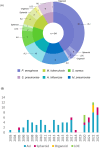In vitro modelling of bacterial pneumonia: a comparative analysis of widely applied complex cell culture models
- PMID: 38409952
- PMCID: PMC10913945
- DOI: 10.1093/femsre/fuae007
In vitro modelling of bacterial pneumonia: a comparative analysis of widely applied complex cell culture models
Abstract
Bacterial pneumonia greatly contributes to the disease burden and mortality of lower respiratory tract infections among all age groups and risk profiles. Therefore, laboratory modelling of bacterial pneumonia remains important for elucidating the complex host-pathogen interactions and to determine drug efficacy and toxicity. In vitro cell culture enables for the creation of high-throughput, specific disease models in a tightly controlled environment. Advanced human cell culture models specifically, can bridge the research gap between the classical two-dimensional cell models and animal models. This review provides an overview of the current status of the development of complex cellular in vitro models to study bacterial pneumonia infections, with a focus on air-liquid interface models, spheroid, organoid, and lung-on-a-chip models. For the wide scale, comparative literature search, we selected six clinically highly relevant bacteria (Pseudomonas aeruginosa, Mycoplasma pneumoniae, Haemophilus influenzae, Mycobacterium tuberculosis, Streptococcus pneumoniae, and Staphylococcus aureus). We reviewed the cell lines that are commonly used, as well as trends and discrepancies in the methodology, ranging from cell infection parameters to assay read-outs. We also highlighted the importance of model validation and data transparency in guiding the research field towards more complex infection models.
Keywords: advanced cell culture models; air–liquid-interface; bacterial pneumonia; lung-on-a-chip; organoid; spheroid.
© The Author(s) 2024. Published by Oxford University Press on behalf of FEMS.
Conflict of interest statement
None declared.
Figures





References
-
- Ahmed W, Bardin E, Davis MD et al. Volatile metabolites differentiate air–liquid interface cultures after infection with Staphylococcus aureus. Analyst. 2023;148:618–27. - PubMed
-
- Badaoui M, Zoso A, Idris T et al. Vav3 mediates Pseudomonas aeruginosa adhesion to the cystic fibrosis airway epithelium. Cell Rep. 2020;32:107842. - PubMed
Publication types
MeSH terms
Substances
Grants and funding
LinkOut - more resources
Full Text Sources
Miscellaneous

